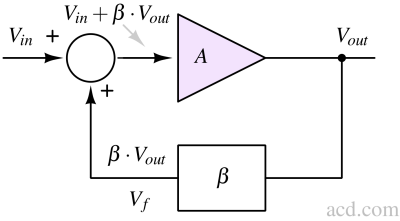Barkhausen Criterion
Barkhausen Criterion for Sustained oscillations¶
The Barkhausen criterion is a mathematical condition to determine oscillation frequency. It has the following conditions that need to be simultaneously satisfied in a positive feedback system:
- The loop gain is equal to unity in absolute magnitude. |A.β|=1. Note the equality sign.
- The phase shift around the loop is zero or an integer multiple of 2π (360°).
In real circuits, the loop gain varies with time. Technically, to start and maintain oscillation, we need time-varying circuits whose loop gain varies. For a fairly simple circuit like a second-order system, the loop gain is more than unity initially and the oscillation amplitude grows. When the active elements saturate, or gain is controlled continuously, the circuit operates in a nonlinear region, which fixes the amplitude. From this point, the average loop gain |A.β| equals 1.

Derivation of Barkhausen's criteria¶
A circuit may incorporate positive or negative feedback, with positive feedback commonly employed when designing an oscillator. Conversely, for creating a stable system, negative feedback is the usual configuration. When the conditions for oscillations are satisfied, both positive and negative feedback systems can generate oscillations. However, in a supposedly stable negative feedback system, oscillations are highly undesirable. Thus, we have explored the oscillation conditions of a negative feedback system as well.
For positive feedback systems¶
To mathematically understand Barkhausen's criteria, let's consider a system configured in a positive feedback manner, as shown in Fig 1.
$$V_{out}=A(V_{in}+\beta{}V_{out})$$
To find the transfer function, we can rearrange the above equation:
$$\cfrac{V_{out}}{V_{in}}=\cfrac{V_{out}}{V_{in}}=\cfrac{A}{1-A\beta{}}$$
For an oscillator, input is unnecessary (or set to zero), classifying it as an autonomous circuit wherein its output inherently generates periodic waveforms. When the input is zero, it still produces a finite non-zero output; this signifies an infinite gain. The transfer function can be regarded as the primary function of the system, providing insight into the conditions for achieving infinite gain in the circuit. To find the condition of infinite gain in the circuit:
$$\cfrac{A}{1-A\beta{}}\rightarrow{}\infty{}$$
We obtain:
$$\implies{}1-A\beta{}\rightarrow{}0$$
or,
$$A\beta{}=1$$
From the above equation, we can observe that the condition of oscillation is :
- The magnitude of the loop gain |Aβ| is unity and
- The angle of the loop gain (∠Aβ) is 2Nπ. (where N ∈ ..,-2,-1,0,1,2,..)
For negative feedback systems¶
Let's analyze a system configured in a negative feedback manner, as shown in Figure 2. Observing the relation between the input of the amplifier (A) and output (Vout), we can write :
$$V_{out}=V_{in}-A\beta{}V_{out}$$
To derive Barkhausen's criteria, we can write the transfer function as follows by rearranging the above equation:
$$\cfrac{V_{out}}{V_{in}}=\cfrac{A}{1+A\beta{}}$$

The condition for infinite gain:
$$1+A\beta{}=0$$
or,
$$A\beta{}=-1$$
From the above equation, we can observe that the condition of oscillation is :
- The magnitude of the loop gain |Aβ| is unity and
- The angle of the loop gain (∠Aβ) is (2N+1)π. (where N ∈ ..,-2,-1,0,1,2,..)
Barkhausen stability criterion¶
The magnitude and phase (angle) criteria must be satisfied simultaneously for the mentioned oscillation condition to be met. In our analysis, we will examine the extent to which the angle condition is fulfilled when the magnitude condition is met and vice versa. Since stability is a concern in a negative feedback system, not a positive feedback system, we shall consider a negative feedback system to define the stability criteria. For a negative feedback system, the gain margin provides information on how distant Aβ is from 1 when the phase is 180°, while the phase margin indicates the deviation of the negative feedback system from 180° when the gain is 1.
Read more - Gain margin and Phase margin
Pitfalls of Barhausen stability criteria¶
If we know that A.β = -1 at some frequency, then we know that the system is unstable. However, if the loop gain is negative and larger than one, we cannot conclude that the system is unstable or oscillating.
References¶
An interesting read - Barkhausen Stability Criterion